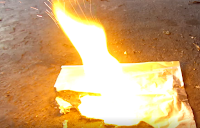I investigated two methods for preparing elemental silicon, the first led to an extremely impure product so I chose not to present it. The second method is a thermite reaction between silicon dioxide and aluminium. Since this reaction isn't thermally self sustaining, a side reaction of sulphur and aluminium is introduced to provide the necessary heat. Many sources of silicon dioxide can be used for the reaction such as silica gel and sand, but I chose to use quartz.
To begin, I added 11.87g (0.1976 moles) of finely powdered quartz, 15.83 (0.4936 moles) of sulphur and 13.19g (0.4888 moles) of 325 mesh aluminium powder to a plastic container. I stirred this mixture intimately until a uniform gray powder was obtained, then poured the powder onto a brick. I placed a piece of magnesium ribbon in the mixture and ignited the ribbon with a torch. A very intense, but fairly slow burning thermite reaction began, giving off large amounts of heat and smoke. Once the thermite was complete, I scraped up the residue and added it to a 500ml beaker containing 200ml of water. After a few seconds, the mixture began giving off a huge amounts of hydrogen sulphide gas, this lasted about 30 minutes. I allowed the mixture to stand with occasional stirring for about 24 hours to insure the evolution of hydrogen sulphide gas was complete. The mixture became a clear liquid with a thick gray precipitate of aluminium hydroxide. Anyway, I stirred the mixture to form a suspension, waited a few seconds, then decanted off the aluminium hydroxide suspension.
With an additional 200ml water added each time, the decantation step was repeated 4-5 times until almost all the aluminium hydroxide had been removed. Left at the bottom of the beaker were a lots of silicon beads, which appeared metallic with a slight bluish luster. I added 50ml of 33% hydrochloric acid and left the silicon to soak in this for 15 minutes with occasional swirling of the beaker. I then decanted off the acid and added 200ml of water to the silicon. I filtered the mixture through a regular kitchen sieve to remove the fine grains of unwanted material and washed the silicon beads caught by the sieve with two 200ml portions of water. After drying, I was left with 3.19g of elemental silicon representing a 57% yield.

Left = silicon beads / Right = quartz and aluminium thermite with sulphur
3 SiO2 + 4 Al ==> 2 Al2O3 + 3 Si / 2 Al + 3 S ==> Al2S3
Al2S3 + 6 H2O ==> 2 Al(OH)3 + 3 H2S / Al2O3 + 6 HCl ==> 2 AlCl3 + 3 H2O
Al(OH)3 + 3 HCl ==> AlCl3 + 3 H2O



